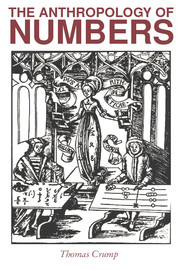Book contents
- Frontmatter
- Contents
- List of illustrations
- Preface
- Acknowledgements
- 1 The ontology of number
- 2 The cognitive foundations of numeracy
- 3 Number and language
- 4 Cosmology and ethnoscience
- 5 Economy, society and politics
- 6 Measurement, comparison and equivalence
- 7 Time
- 8 Money
- 9 Music, poetry and dance
- 10 Games and chance
- 11 Art and architecture
- 12 The ecology of number
- Notes
- References
- Index
- Cambridge Studies in Social and Cultural Anthropology
9 - Music, poetry and dance
Published online by Cambridge University Press: 05 June 2012
- Frontmatter
- Contents
- List of illustrations
- Preface
- Acknowledgements
- 1 The ontology of number
- 2 The cognitive foundations of numeracy
- 3 Number and language
- 4 Cosmology and ethnoscience
- 5 Economy, society and politics
- 6 Measurement, comparison and equivalence
- 7 Time
- 8 Money
- 9 Music, poetry and dance
- 10 Games and chance
- 11 Art and architecture
- 12 The ecology of number
- Notes
- References
- Index
- Cambridge Studies in Social and Cultural Anthropology
Summary
The two structures of music: inherent and imposed
Music, in any form, is a purely cultural institution, with a distinctive numerical base. It is not essentially related to any of the so-called ‘sounds of nature’, although, as Lévi-Strauss (1974:296f.) has shown, such a relationship, in relation to elementary musical instruments, is a fundamental assumption in any number of different cultures. Indeed, ‘music[…]must be appreciated for what it is: it is intended to be heard as human organised sound’ (Blacking 1968: 313), even though the instruments used in the production may be thought of as ‘being made to cry’. The principle of organisation is always numerical. One may compare the cases considered in chapters 7 and 10, of which the former shows how the calendar is the means for ordering time, and the latter, how the rules are the means for ordering play in the form of a game. In both cases the parallel can be drawn still further. Music has its own special world of virtual time, to which we are transported away from the world of culturally regulated actual time. Or as Stravinsky has said, ‘Music is given to us with the sole purpose of establishing an order in things, including, and particularly, the coordination between man and time’ (ibid.: 314).
- Type
- Chapter
- Information
- The Anthropology of Numbers , pp. 103 - 114Publisher: Cambridge University PressPrint publication year: 1990



